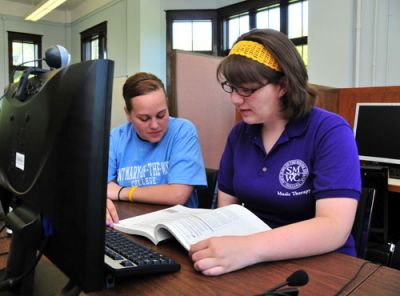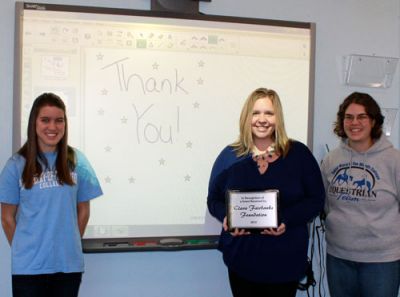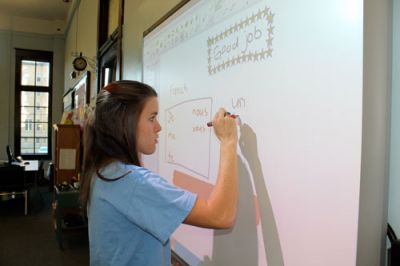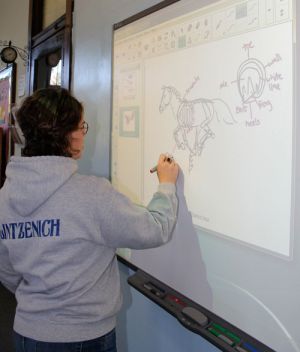
SMWC campus and distance students use the learning resource center for tutoring, writing assistance and group and individual study.
When Lauren Sutton, a senior at SMWC, watches students calculate the length of a hypotenuse, they aren’t always sitting in front of her. In fact, sometimes they are hundreds of miles away.
“If a student logs on between 6:30 and 8:30 p.m., they’ll get an online tutor right away,” said Sutton, a professional writing major from Noblesville, Ind. “But we can arrange other times, too. We have the textbooks right here so we can turn to the same page to help them with a specific question.”
Sutton is a student tutor in SMWC’s cutting-edge learning resource center (LRC). Under the creative leadership of the center’s director, Kimberly LaComba, tutors can access distance students’ computers and help them solve an equation, edit an essay or practice for a test. Utilizing the College Reading and Learning Association (CRLA) standards, tutors, like Sutton, use technology and encouragement to help students make academic milestones. “We take a proactive approach to student success,” LaComba said. “Our center is inclusive of all students – both campus and distance. That really makes us unique.”
Using Adobe Connect, tutors can watch students graph coordinates, solve algebraic equations, create an outline and correct grammatical errors – all in real time. “I can watch the online students work out the problem step-by-step,” Sutton explained. “Then I can review their process and see where they may be getting hung up.”

Student Stephanie Runyon, LRC director Kim LaComba and student Devin Lintzenich show their appreciation for the grant.
Thanks in part to a $4000 grant from the Clara Fairbanks Foundation, SMWC recently upgraded the LRC’s academic assistance technology, including a SMART board and projector, an additional computer and a wireless keyboard and mouse. “Saint Mary-of-the-Woods College is a jewel in the academic world,” said James Owen, president of the Clara Fairbanks Foundation. “I was amazed at the capability of the SMART technology, which will vastly expand the process of learning. The more students learn, the more they pass on to the world.”
The SMART board, which uses touch detection for user input and a projector to display the computer’s output, is like a dry-erase board, a touch screen and a computer all rolled into one. Grabbing a digital-ink marker, Sutton plots points on a graph and solves equations, all while tapping, touching and clicking menus. “SMART technology helps us reach more students with different learning styles,” LaComba said. “With SMART technology, the kinesthetic learner is able to touch the screen, the visual learner can view pictures to help with retention and the auditory learner can listen to more than just the lecture- all at once.”

SMWC student Stephanie Runyon conjugates French words using the LRC’s new SMART board.
Being paired with campus students deepens the online students’ connections to the College, keeping them more engaged and involved in the Woods community. “I help students stay consistent, organize their thoughts and achieve their goals,” said peer tutor Stephanie Runyon, a senior English education major from Noblesville, Ind. “But it’s also helping me learn what it takes to be a good teacher. I’m learning the importance of giving positive feedback, so that they are encouraged and not discouraged.”
That’s what makes the LRC an interdisciplinary culture of discovery. The benefits are symbiotic. Sutton and Runyon learn effective leadership skills, while exploring advanced technology. The students they help are able to bolster their strengths and overcome obstacles, developing a passion for lifelong learning. With doors wide open, students can stroll into the LRC anytime for a quiet place to read, do group work or use the technology for individualized study.
“We guide not give,” LaComba explained. “We encourage students to find answers on their own. We support the individual’s learning process, helping them build skills like self-management and communication, while working on specific academic concepts.”

SMWC student Devin Lintzenich diagrams the anatomy of a horse on the SMART board.
In addition to its inclusive campus and distance tutoring programs, the LRC also:
- Prepares students and is a testing site for the College-Level Examination Program (CLEP), Test of English as a Foreign Language (TOEFL), Core Academic Skills Assessment (CASA), the Praxis exam and the new Praxis 1 replacement course that begins in January 2013.
- Teaches the foundational course ID110: Succeeding in the College Environment, which helps students optimize their learning styles and develop effective study skills and test-taking strategies.
- Provides advising support and accommodations to students with disabilities.
- Assists students with writing and communication skills, such as idea development, organization refinement and research strategies.
LaComba vows that the College’s LRC will never stop growing. Even as they installed the new SMART board, she was already working on plans for even more inclusive technology, such as webcams and more audio. “Here in the LRC we show that the student is most important and that we believe they can achieve their academic goals,” LaComba said. “And they do.”
Learn more about how SMWC’s learning resource center supports student success!
